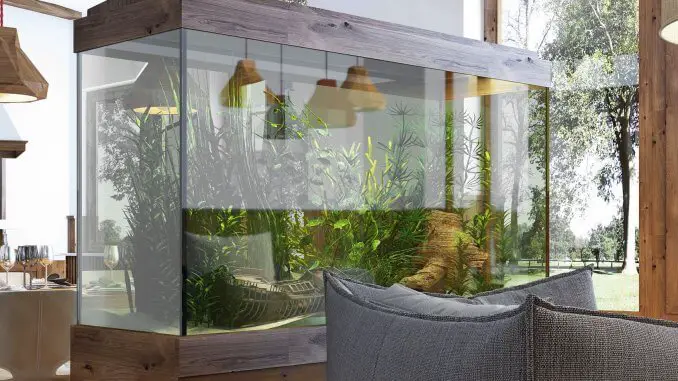
100-gallon fish tanks are ideal for aquascaping and can house large schools or exotic fish such as rainbow sharks, discus fish, and butterfly fish. 100-gallon fish tanks come in all shapes, styles, and materials, though most are made from glass or acrylic and measure 40 to 73 inches long, 18 to 24 inches wide, and 19 to 25 inches tall.
While attractive, 100-gallon tanks aren’t suitable for beginner fish keepers. These aquariums are costly to maintain and require specialized equipment.
TABLE OF CONTENTS
Best 100 Gallon Fish Tanks Reviewed
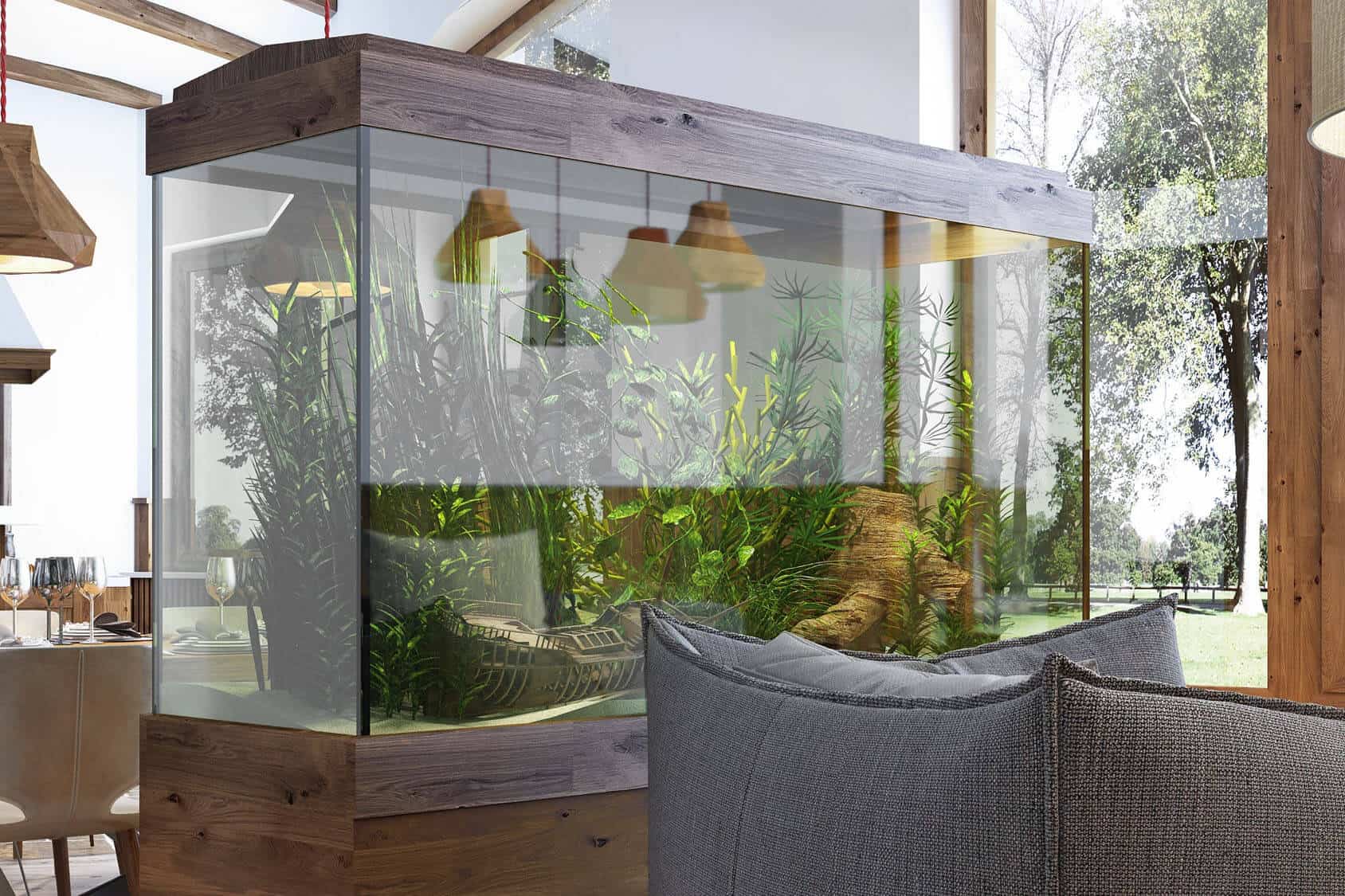
We reviewed a variety of fish tanks and considered factors such as price, shape, material, features, assembly, and ease of use. Certain 100-gallon tanks will be better suited to your needs than others.
The best 100-gallon fish tanks available on the market include:
| Tank name | Best for | Key features | Check Price |
Red Sea Max S-Series 400 | Best for reef and marine aquariums, saltwater tanks |
| Check Price |
Clear-For-Life Rectangle UniQuarium
| Best for freshwater tanks |
| Dream Fish Tanks |
Aqueon LED Aquarium | Best for fishkeepers on a budget |
| Check Price |
Tsunami Half Cylinder
| Best half cylinder-shaped tank |
| Fish Tanks Direct |
Red Sea Max S-Series 400: Best for Reef and Marine Aquariums

The Red Sea Max S-Series 400 is an innovative marine aquarium that’s been specially designed to support coral reef systems, with features such as a full-width surface skimmer, reef-spec filtration, and built-in LED lighting optimized for corals’ growth.
The Red Sea Max S-Series 400 has a sophisticated, contemporary design and measures 41 inches long and 25 inches tall. The aquarium is extremely customizable, even down to the trim color, and comes with all the fishkeeping essentials, like a durable aquarium stand and in-cabinet sump.
While large and packed with features, the aquarium is easy to maintain because its equipment is connected to a centralized control panel. The tank also has overflow protection and an automatic top-up system that helps keep water parameters stable.
PROS
- All-in-one marine aquarium kit; reef ready
- Easy maintenance
- Reef-optimized lighting system
- Automatic top-up system
- Overflow protection
- Sleek, contemporary design
CONS
- Open top (no lid)
- Expensive
Clear-For-Life UniQuarium: Best for Freshwater Tanks
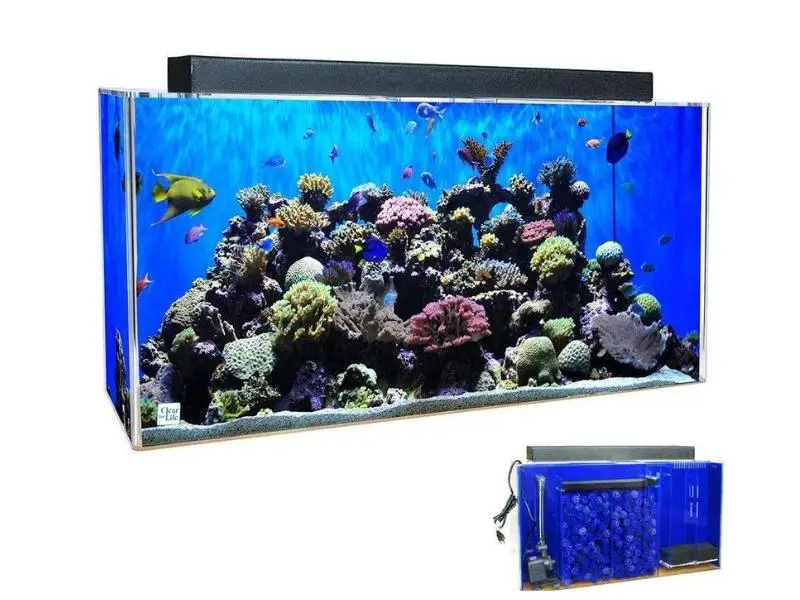
The Clear-For-Life UniQuarium is a rectangular-shaped tank made from thick acrylic. The aquarium holds up to 100 gallons and comes with a durable polycarbonate lid to prevent fish from jumping out of the water. The tank measures 60 inches long, 18 inches wide, and 20 inches tall.
This tank is ideal for freshwater setups — especially tropical setups — because it retains heat well and has a dark background color to show off exotic species’ vibrant scales. The kit comes with a 3-in-1 filtration system — mechanical, chemical, and biological — and chambers for a protein skimmer and heater. All the equipment is hidden at the back of the tank.
The tank runs silently, is exceptionally durable, and is backed by a lifetime warranty. The Clear-For-Life UniQuarium is also easy to assemble as it doesn’t involve any plumbing or drilling.
PROS
- Ideal for freshwater fish
- Made from high-quality acrylic
- 3-in-1 filtration system
- Secure polycarbonate lid
- Dark background color
- Easy to assemble
- Lifetime warranty against defects
CONS
- Have to buy aquarium stand separately
- Scratches easily
Aqueon LED Aquarium: Best for Fishkeepers On a Budget

The Aqueon LED Aquarium is a glass tank that measures 72.5 inches long, 18.5 inches wide, and 23.4 inches tall. The aquarium is extremely affordable and can hold up to 125 gallons. The glass is thick, clear, and easy to clean.
The Aqueon LED Aquarium comes with a durable black frame, a showpiece-worthy stand, and two built-in LED strips that distribute light evenly throughout the tank.
The longer tank shape, which allows for a deep substrate, makes the Aqueon LED Aquarium well-suited to bottom-dwelling fish that enjoy burrowing.
PROS
- Affordable
- Clear, thick glass
- Long and spacious
- Built-in LED lighting
- Attractive stand design
CONS
- Heavy
- Equipment sold separately
- Stand is flimsy
Tsunami Half Cylinder: Best Cylinder-Shaped Tank
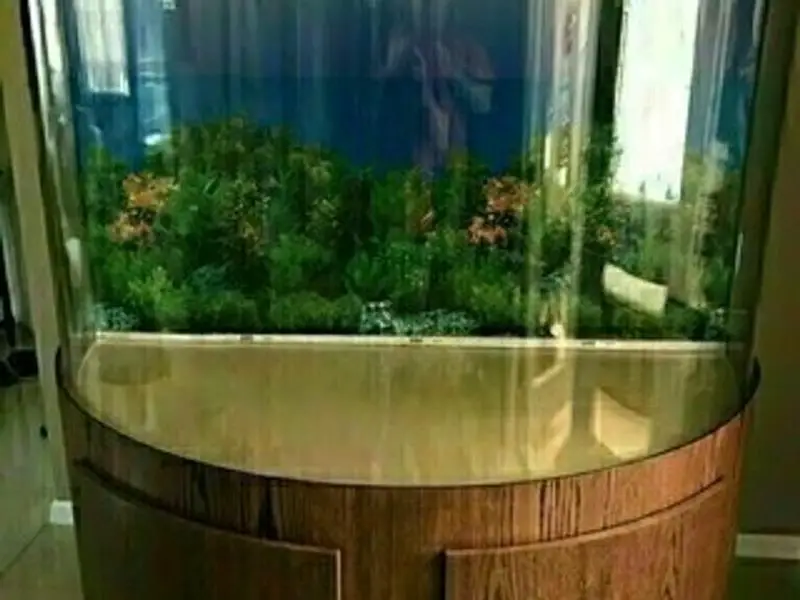
The Tsunami Half Cylinder tank is a premium aquarium that stands 24 inches tall, 48 inches long, and 24 inches wide. The tank is made from high-quality acrylic and boasts an elegant, sophisticated look.
The Tsunami Half Cylinder tank can be bought separately or with a stand, canopy, and overflow. The aquarium can also be fitted with a splash pan to protect against leaks and splashes. Almost every part of this kit can be customized to suit your needs and tastes, including the stand material, overflow color, background panel color, and canopy height.
While this tank can accommodate all kinds of aquatic species, its shape is ideal for tall-bodied fish like angelfish.
PROS
- Acrylic tank
- Sophisticated look
- Fully customizable
- Durable made from high-quality materials
- Ideal for tall fish species
CONS
- Extremely expensive
- Gear sold separately
Best Fish to Keep in a 100 Gallon Tank (& How Many)
A 100-gallon tank is spacious and can house all kinds of species. The tank can easily accommodate a community setup, schools of fish, or large species that grow up to 15 inches. Bottom-dwelling, burrowing species are also well-suited to this tank size, as long as the tank is wide and has a thick substrate.
Ensure all tank mates are compatible with each other — similar in temperament and size — as well as compatible with the tank’s water parameters. Don’t overcrowd the aquarium.
Great saltwater fish and freshwater fish for 100-gallon tanks include:
- Butterfly fish: A 100-gallon fish tank can house up to two butterfly fish, depending on the particular species. Butterfly fish are best kept alone or in pairs
- Discus fish: A 100-gallon tank can house up to 10 discus fish, depending on size and tank setup. Females must outweigh males at a 2:1 ratio
- Oscar fish: A 100-gallon fish tank can accommodate one adult oscar fish. Oscar fish are aggressive toward their own species and shouldn’t be kept together
- Rainbow sharks: A 100-gallon tank can house up to one rainbow shark. Like oscar fish, rainbow sharks exhibit territorial aggression and are best kept alone
- Angelfish: A 100-gallon fish tank can house up to five angelfish. Ensure the tank houses at least two females for every male
Angelfish and butterfly fish are sure to liven up the tank with their bold, vibrant colors, while rainbow sharks’ feisty personalities are sure to keep you entertained.
Equipment Needed to Set up a 100 Gallon Fish Aquarium
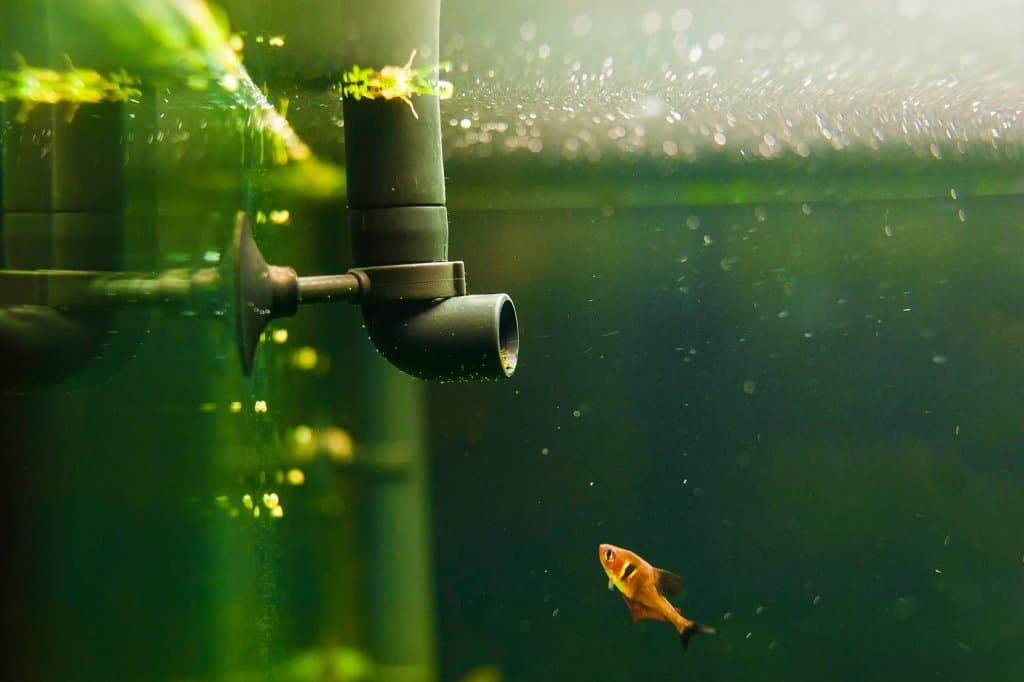
A 100-gallon tank requires several pieces of equipment to keep the species inside the tank healthy and happy, including a filtration system, heater, and sump.
The exact equipment and decorations needed to depend on the tank setup — freshwater aquarium or saltwater aquarium — and the fish’s preferred living conditions.
Filters
A filter helps keep water parameters stable and rids the tank of debris, leftover food, decaying matter, and harmful contaminants like ammonia and nitrate. A filter also helps aerate the water so the fish are able to breathe properly.
There are several types of filtration systems, including sponge filters, under gravel filters, and power filters, but the best filtration system for a 100-gallon tank is a canister filter.
Canister filters are easy to set up, have a high flow rate, and can hold multiple types of filter media. Because canister filters are kept outside the main tank, there is no risk of the fish becoming caught in the filter intakes. Most high-quality canister filters come with long warranties and run quietly.
Heaters
Most aquatic species require water to stay at a specific temperature to thrive. Drastic temperature fluctuations affect the water quality in the tank and can cause fish to become distressed or sick.
A dedicated heater gives you complete control of the tank’s water temperature, keeping fluctuations to a minimum. There are a wide array of aquarium heaters available, including submersible, immersible, filter, substrate, and in-line heaters — each suited to different needs and tanks.
No matter which heater you choose, ensure the heating capacity matches the tank size. Most 100-gallon tanks require a heating capacity of 250 to 350 watts, with the exact capacity depending on room temperature and how well the tank retains heat.
Some cool water aquarium species can survive without a heater, so always familiarize yourself with the fish’s ideal water parameters before investing in equipment.
Plants & Decorations
Plants and decorations help simulate the fish’s natural habitat, disperse strong currents, and provide plenty of hiding spots. Spreading plants and decorations throughout the tank can also reduce territorial aggression between fish.
Floating plants, which keep the tank sheltered from light, are particularly ideal for nocturnal species or fish with low lighting needs.
Substrate
A substrate encourages healthy bacteria growth, enhances the overall look of the tank, and allows bottom-dwelling species to engage in natural behaviors like burrowing and foraging. Aquarium substrate comes in a range of colors and is commonly made from gravel or sand.
Top-dwelling species often don’t require a substrate, but adding a substrate can still enhance the overall look of the tank and help show off a fish’s coloration.
Lighting
Lighting lets you establish a natural day-to-night cycle in the tank, allows live plants to photosynthesize, and helps show off a fish’s coloration.
Every aquatic species has different lighting preferences. Some species are accustomed to low lighting (1 to 2 watts per gallon of water) while others thrive in moderate lighting (3 to 5 watts per gallon). A marine reef tank with lots of corals requires stronger lighting than a fish-only tank, typically in the region of 4 to 8 watts per gallon.
Avoid harsh, bright lighting because this stresses most fish and encourages harmful algae growth.
Sumps
A sump is a small, additional tank that attaches to the main aquarium. Sumps help keep water parameters stable and provide more space for equipment like filtration systems. Sumps also allow you to easily put supplements into the water without disturbing the tank inhabitants.
A sump system that holds between 15 and 30 gallons is ideal for a 100-gallon tank. A reef aquarium, which requires low nitrate levels, particularly benefits from a sump fitted with a protein skimmer.
Stands and Lids
Most 100-gallon fish tanks come with an aquarium stand that has been specially designed to support the tank’s size and weight. However, you can buy your own stand or even use a sturdy, durable cabinet in your home.
Ensure that the stand has a larger surface area than the tank. The stand must also accommodate the tank’s full weight — 100-gallon tanks can weigh over 800 pounds when filled with water, decorations, fish, and substrate.
Other equipment to consider investing in is a tank lid. A lid helps the tank retain heat, prevents fish from jumping out of the water, and reduces water evaporation.
How to Choose a 100 Gallon Fish Tank
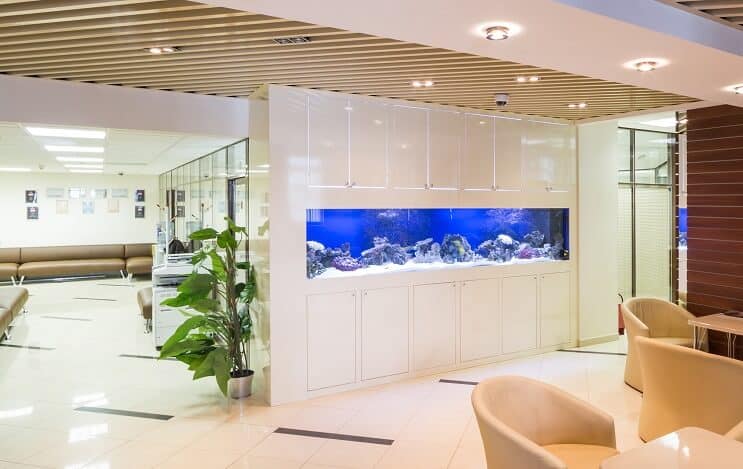
There are several factors to consider when choosing a 100-gallon fish tank, including construction materials, tank shape, and your budget.
Construction Materials & Quality
Most modern tanks are made from glass or acrylic. Each material has its fair share of pros and cons, though both are durable and allow you to see inside the tank.
| Material | Pros | Cons |
| Glass |
|
|
| Acrylic |
|
|
Price
A 100-gallon tank can cost between $700 and $5,000, with the exact price depending on the material, brand, aquarium stand quality, and if the tank comes with any accessories or additional equipment.
Always invest in a high-quality heater because cheap alternatives often fail. Save money by opting for a glass tank instead of an acrylic tank. However, glass tanks are heavy and difficult to accommodate without a durable stand.
Space Available
100-gallon tanks measure up to 40 to 72 inches long and 24 inches wide, so make sure your home can comfortably fit a tank of this size before purchasing one. You should also have plenty of room to accommodate additional aquarium equipment and cleaning tools.
Don’t place the new tank near electrical outlets, direct sunlight, or noisy areas. Ensure the floor is level and can hold the tank’s weight.
Tank Shape
There are several different tank shapes available, but the most common are rectangular, half-cylinder, cylinder, and bowfront. The most suitable tank shape depends on your living environment and the fish you intend to keep inside the tank. Rectangular and bowfront tanks typically take up more space in the home than cylinder tanks.
Bottom-dwelling species do best in tanks with more width than height, while tall aquariums are better suited to fish with tall bodies like angelfish.
Conclusion: Is a 100 Gallon Fish Tank the Right Size for Your Aquarium?
A 100-gallon aquarium is an attractive, large tank that can house all kinds of captivating and colorful fish. You should get a 100-gallon fish tank if you’re experienced with fishkeeping, can afford the tank’s maintenance, and can accommodate its size. You shouldn’t get a 100-gallon tank if you’re new to fishkeeping or live in a small, cramped apartment.
While a 100-gallon tank is a big investment, it’s sure to be a rewarding experience and add a touch of sophistication to your home.
100 Gallon Fish Tank FAQs
Frequently asked questions about 100-gallon fish tanks include:
How Many Fish Can a 100 Gallon Tank Hold?
A 100-gallon fish tank can accommodate one to dozens of fish, depending on the species and how heavily decorated the tank is. When stocking a tank, a good guideline to follow is the 1 inch of fish per 2 gallons of water rule. However, always consider the fish’s temperament, full adult size, swimming behavior, and tank mate compatibility.
Large, aggressive species are best kept alone in the tank, while small, docile schooling fish like discus thrive in groups of six or larger.
How Much Does a 100 Gallon Fish Tank Weigh?
An empty 100-gallon fish tank weighs around 200 pounds. However, when full of water the tank can easily weigh over 800 pounds. Glass tanks weigh significantly more than acrylic tanks.
Other factors that can affect tank weight include decorations, substrate, and how many fish the tank holds. A saltwater tank is slightly heavier than a freshwater tank because of water density differences.
What Are the Dimensions of a 100 Gallon Fish Tank?
Most 100-gallon tanks measure 40 to 72 inches long, 18 to 24 inches wide, and 20 to 25 inches tall. The exact dimensions depend on the tank shape.
An aquarium stand can also drastically increase the overall size of the setup. A stand for a 100-gallon fish tank is usually around 35 inches tall, 24 inches wide, and 70 inches long. Larger tanks include 120 gallons, 150 gallons, and 210 gallons.
Is a Sump Good for the 100 Gallon Aquarium?
Yes, a sump is good for most 100-gallon aquariums because it improves water quality and keeps bulky equipment out of sight.
A sump, while ideal, isn’t necessary as long as you’re able to maintain stable water parameters and can accommodate the necessary equipment elsewhere. Perform more frequent water changes without a sump, ideally 20% per week.
How Long Is a 100 Gallon Fish Tank?
Most 100-gallon fish tanks are 40 to 72 inches in length. Rectangular-shaped tanks, which are typically between 50 to 72 inches long, are the longest 100-gallon tanks, while cylinder-shaped tanks, which measure around 30 to 40 inches long, are the most compact 100-gallon tanks.
A fish tank’s length can also be affected by additional equipment like a side filtration system.

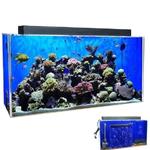
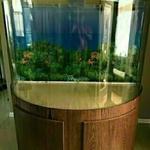

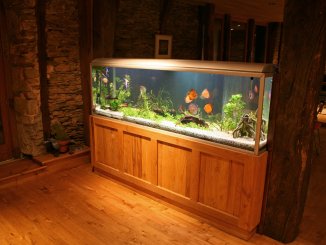
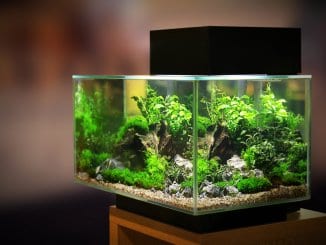
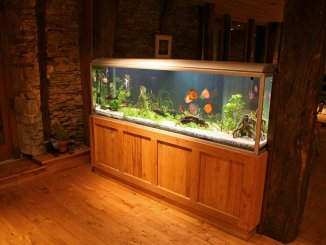
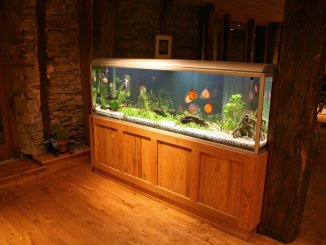
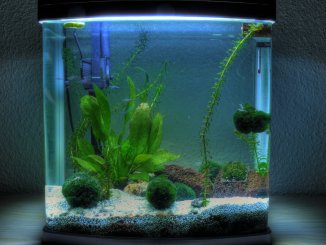
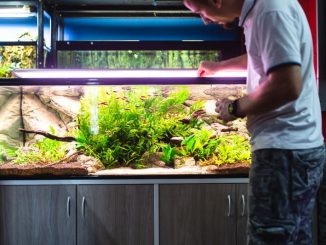
I’ve had my 100 gallon for a few years now. Had a few Koi but I lost one in a move and the other one shortly after. I’ve switched to a community tank with an Angelfish and a couple albino Cory’s. I’ve recently decided to tackle a planted tank and suddenly keeping my PH up is a daily battle. I have tried API ph up. It wont hold. I’ve recently added Limestone to the tank. Hoping it helps. Next thought is Coral. Any thoughts or tips on why the sudden problem or best natural way to fix it? Thanks